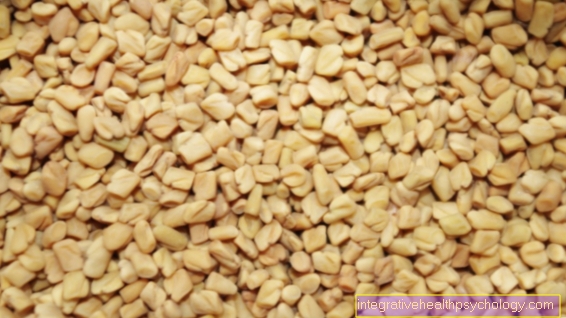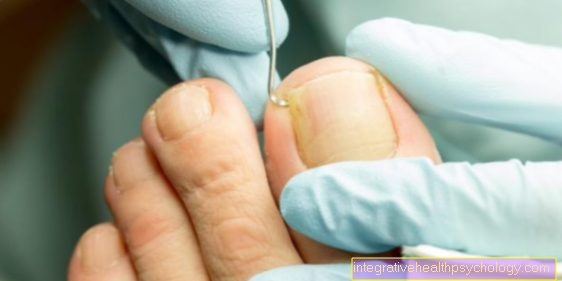Wick VapoRub® cold ointment
What is the Wick VapoRub® cold ointment?
The Wick VapoRub® cold ointment relieves the symptoms of a cold such as cough, hoarseness and a stuffy nose. It contains various active ingredients, including eucalyptus oil and camphor. It is intended for external use on the chest and back. It is available in pharmacies, but you don't need a doctor's prescription to buy it. Wick VapoRub® can be used in children from the age of two, adolescents and adults. In addition to the dosage form as an ointment, Wick VapoRub® is also available as a spray or inhaler pen.

What are the indications for the Wick VapoRub® cold ointment
The term “indication” comes from medical terminology and means something like: “reason for therapy”. If there is an indication, there are good reasons to use the appropriate drug or therapy to improve the disease. Indications for the use of the Wick VapoRub® cold ointment are coughing, hoarseness, congested sinuses, runny nose and congested airways.
Wick VapoRub® makes breathing easier, especially at night, when the mucus gets stuck in the airways of the lungs and the sinuses of the nose because the upper body is in a horizontal and not in a vertical position. The Wick VapoRub® nasal spray and inhaler pen are particularly suitable if the symptoms of the common cold are mainly limited to the nose. The cold ointment, which can be applied to the chest and / or back, will help if the cold also affects the airways to and in the lungs.
How does Wick VapoRub® cold ointment work?
The Wick VapoRub® cold ointment initially contains the four actual active ingredients. The eucalyptus oil, camphor, levomenthol and turpentine oil. The additives white vaseline, juniper wood oil and thymol are added to these. Eucalyptus oil helps to thin tough, stuck mucus, making it easier to cough up. Camphor also loosens and thins the mucus and also stimulates blood circulation. Levomenthol has a cooling, analgesic, antispasmodic and antimicrobial effect in low concentrations. The fourth active ingredient, purified turpentine oil, also helps to loosen mucus and also prevents the formation of new mucus.
All of these active ingredients work primarily by evaporating after application to the skin. The essential vapor can then be inhaled through the nose and mouth. In this way, the substances reach their actual sites of action, the sinuses of the nose and the bronchi in the lungs. The additives also contribute to the effect of the cold ointment. The white petroleum jelly binds the various active ingredients and ensures that it can be rubbed onto the skin as an ointment. At the same time, it protects the skin from drying out.
Juniper wood oil provides a pleasant smell and is said to have disinfecting properties. So it is able to kill bacteria and viruses to a certain extent. The thymol is a component of the thyme oil and has an antiseptic effect, i.e. it kills pathogens and is expectorant. The Wick VapoRub® cold ointment therefore contains active ingredients that together have an expectorant and antiseptic effect.
Side effects of the Wick VapoRub® cold ointment
One speaks of side effects when, in addition to the desired effect, other effects occur, which usually have negative consequences. In the case of the Wick VapoRub® cold ointment, no comprehensive studies are known that have examined possible side effects. However, there have been isolated reports of side effects. These include above all allergic reactions of the skin and mucous membranes. This manifested itself in redness, eczema and other skin irritations. The affected areas may also burn or hurt.
Hallucinations and seizures have been reported rarely. However, such side effects are actually isolated cases that can by no means be generalized. Due to the rising vapors, the mucous membranes of the eyes can also react to the ingredients, for example with increased tear fluid formation, itching or reddening. As already mentioned, side effects are very rare when using the cold ointment. However, should this ever happen, the ointment should be removed from the body immediately. If very severe side effects occur, it is also advisable to consult a doctor.
Interactions of Wick VapoRub® cold ointment
Interactions can occur when taking different drugs at the same time. The drugs then increase or weaken each other's effects. Eucalyptus oil changes the enzyme structure in the liver when it is absorbed through the skin. As a result, more enzymes are available to break down foreign substances, for example drugs. The consequence is the increased and faster breakdown of these substances, which drastically reduces the effect of drugs. If the Wick VapoRub® cold ointment is to be used over a longer period of time and other medications are being taken at the same time, a short conversation with a pharmacist or doctor can be useful to clarify possible interactions.
Counter-indications for Wick VapoRub® cold ointment
Counter-signs are reasons not to use a drug and are also known as contraindications. The Wick VapoRub® cold ointment should not be used if there are allergies to the ingredients. It is also recommended not to apply it to open wounds and skin areas, burns and rashes. The cold ointment must also not be used in the event of pneumonia or other chronic irritation of the airways. It should only be used in children aged two and over, so a counter-sign is an age of less than two years.
How often should I use the cold ointment?
The Wick VapoRub® cold ointment should not be used for more than three to five days. If the cold symptoms persist, a doctor or pharmacist should first be consulted before the ointment is used again. Adults and children over the age of twelve can rub about two to three teaspoon-sized portions on the chest, back and neck two to four times a day. It is recommended to massage in the ointment in slow movements and then put on loose-fitting clothing so that the essential oils can better evaporate and be inhaled.
How much does Wick VapoRub® cold ointment cost?
Depending on the offer and the size of the pack, the Wick VapoRub® cold ointment costs between 5 and 13 euros. The price varies depending on the special offer and pharmacy. You can also buy the cold ointment on the Internet. On the Internet, too, the price depends heavily on the selling website. The Wick VapoRub® spray is slightly cheaper on average at five to six euros. The inhaler pen also usually has a lower price of around three euros.
What should be considered when using it with babies and children?
The Wick VapoRub® cold ointment can also be used on babies and children, but only from the age of two. Before that, the effect of the ingredients is too aggressive for the respiratory tract of the little ones and there would be more irritation than an improvement in the cold symptoms. For children between the ages of two and four, ½ to a teaspoon of the cold ointment can be spread over the chest and back two to three times a day. However, the ointment should never be applied to the neck, face or nose of children. Children between the ages of six and twelve can be rubbed one to two teaspoon-sized amounts of ointment on their backs and chest.
Again, as soon as side effects occur, wash off the ointment immediately and consult a pediatrician. If small children accidentally swallow some Wick VapoRub® cold ointment, they should also consult a pediatrician immediately, as the essential oils can lead to severe abdominal pain. Children under the age of six should not inhale the cold ointment. If they are over six years old, one to two teaspoons of the ointment can be dissolved in a bowl of hot water and the child inhaled the steam. The warm, by no means hot, steam also helps to loosen the mucus. Of course, adults can also inhale Vicks VapoRub®.
Wick VapoRub® cold ointment during pregnancy
There is no research showing that the Wick VapoRub® cold ointment poses a health risk during pregnancy. Nevertheless, a doctor should be contacted before use, because depending on the individual health, there may be counter-indications for the use of Wick VapoRub®. Under no circumstances should the Wick VapoRub® cold ointment be used during breastfeeding.The baby may swallow small amounts of the ointment while breastfeeding. The consequences would be abdominal pain and, in the worst case, a glottic cramp. In addition, the vapors that the baby could inhale would be very aggressive to their airways and could cause irritation.





























